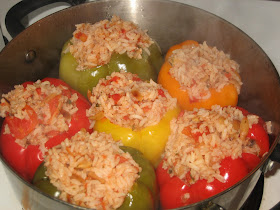 |
| Homeschool Record Keeping, The Annual Academic Summary |
At the end of a year of homeschool, it's a great feeling to be able to look back and see all that we've accomplished! An Annual Summary makes that possible.
What is an Annual Summary? It is a document that lists every resource we used in the course of a year, all in one place. Every book read, every concert attended, every skill acquired. But, unlike the Daily Log, it doesn't show the day-to-day, just the big overview.
It is very easy to assemble, and I update it as I go.
When I create an annual summary, I try to keep in mind what things
are considered educational in traditional schools, and/or are required
by my state, that I might tend to overlook when recording. For instance,
"academic hours" in traditional schools include such things as
attending concerts, finger painting, fire drills, field trips, learning
about culture and traditions, attending plays, and learning about
bowling. And, in Christian schools, academic hours also include chapel,
religious education, singing hymns, Sacraments, and Bible reading. If
you just think "3 Rs" it's easy to mistakenly overlook a ton of academic
hours.
Here is a fictitious annual summary (for the sake of my daughter's online privacy). She's not really in First Grade, nor are these our current materials. However, many of the First Grade materials I used for this example ARE ones I am enthusiastic about! : )
First, I create a Word Processing document - I keep this one on my computer desktop all year for easy access, along with my other record keeping documents.
(Feel free to copy & modify this template for your own use. That's what it's there for!)
The document itself is entitled with the current grade, like this:
"First Grade, Annual Academic Summary"
Then, I paste my template into my desktop document:
Annual Summary, First Grade
Religion:
Language, English:
Reading:
Spelling:
Writing:
Foreign Language:
History, US, State History,
National, State & Local Government, Geography:
Math:
Science:
Health:
Physical Education:
Fine Arts & Music:
Home Ec:
First Aid, Safety
& Fire Prevention:
As the year goes, I enter our completed academic accomplishments and experiences into the document. I add specific titles, authors, and URLs, rather like a bibliography.
It looks something like this (but of course, will probably be longer than this at the end of a year of study!) :
Annual Academic Summary, First Grade
Religion:
The Beginner's Bible
Attending Sunday School
Liturgy on Sundays
Family Devotions: Reading Genesis & Matthew
Learning the Lord's Prayer
Attending Baptism of Baby Nicholas Pappas
Attending Wedding of Maria and Andreas Kostas
Language, English:
Reading:
Learning Phonics with Blend Phonics
http://donpotter.net/pdf/reading_made_easy_with_blen.pdf
Bob Books
The Beginner's Bible for Toddlers
The Cat in the Hat by Dr. Seuss
Starfall Learn to Read
https://www.starfall.com/h/ltr-classic/
Spelling:
McGuffey Speller by Alexander H. McGuffey, pages 3-5
Writing:
Copycat Books, Proverbs
http://www.copycatbooks.com/
Foreign Language:
Salsa Spanish Videos
http://www.gpb.org/salsa
Duolingo Spanish, alphabet lessons
https://www.duolingo.com/course/es/en/Learn-Spanish
History, US, State History,
National, State & Local Government, Geography:
Visiting State House
Heritage Village Field Trip
Liberty's Kids videos
If You Sailed on the Mayflower in 1620 by Ann McGovern
Math:
Khan Academy First Grade Math
https://www.khanacademy.org/math/cc-1st-grade-math
Starfall Games
https://www.starfall.com/h/math0/
Science:
E-Learning for Kids
https://en.e-learningforkids.org/science/
Greg's Microscope by Millicent Selsam
Field trip to Natural Science Museum
Health:
Attending Health Fair at Park
Learning Song about Brushing Teeth
https://www.youtube.com/watch?v=wCio_xVlgQ0
Physical Education:
Swimming Lessons
Folk Dance Lessons
Riding Scooter
Fine Arts & Music:
Field Trip to Art Museum
Making Stamp Art with Cut Potatoes and Paint
Piano Lessons at Hoffman Academy
https://www.hoffmanacademy.com/
Attending play: Little Red Riding Hood at Community Playhouse
Home Ec:
Making Peanut Butter and Jelly Sandwiches
Sweeping with a Broom
Emptying Dishwasher
First Aid, Safety
& Fire Prevention:
Attending Fire Safety Day at Firehouse
Fire Drill
Learning about hydration and heat safety
Water Safety lessons at Swim Class
**************************************************************
That's it! By keeping this on my computer desktop (and I do sit at my computer to teach), it is very easy to update this document regularly. Every time my daughter finishes reading a book, it goes in the log. If she reads parts of a book, like three chapters from a science textbook, I add the word "selections" after that entry. Field Trips, Cultural experiences, Phys Ed outings, and Religious instruction are all included.
At the end of the year, this document is printed and hole-punched, and goes in the front of the Portfolio.


























